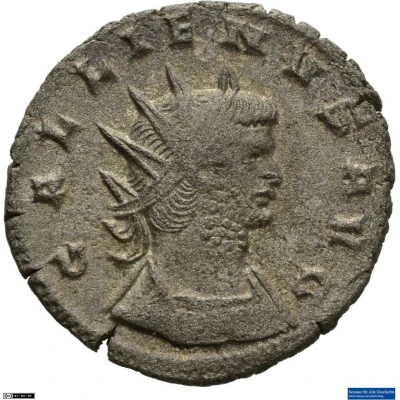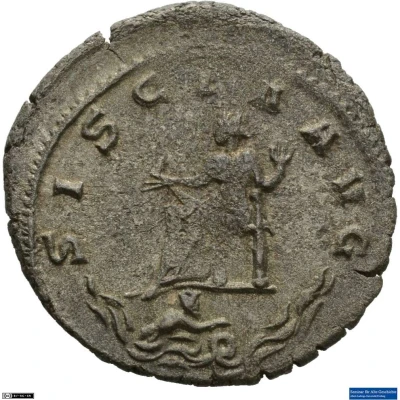


© Münzsammlung des Seminars für Alte Geschichte, Albert-Ludwigs-Universität Freiburg (CC BY-NC-SA 3.0 DE)
Antoninianus - Gallienus SISCIA AVG; Siscia
| Silver | 3.5 g | 22 mm |
| Issuer | Rome › Roman Empire (27 BC - 395 AD) |
|---|---|
| Emperor | Gallienus (Publius Licinius Egnatius Gallienus) (253-268) |
| Type | Standard circulation coin |
| Years | 260-268 |
| Value | Antoninianus (1) |
| Currency | Antoninianus, Reform of Caracalla (AD 215 – 301) |
| Composition | Silver |
| Weight | 3.5 g |
| Diameter | 22 mm |
| Shape | Round (irregular) |
| Technique | Hammered |
| Demonetized | Yes |
| Updated | 2024-10-05 |
| Numista | N#289342 |
|---|---|
| Rarity index | 100% |
Reverse
Siscia, draped, seated left on bank of river (Savus) in which is swimming a river nymph.
Script: Latin
Lettering: SISCIA AVG
Unabridged legend: Siscia Augusti.
Translation: Siscia of the emperor.
Comment
Example of this type:Münzsammlung des Seminars für Alte Geschichte, Albert-Ludwigs-Universität Freiburg
Source:
Online Coins of the Roman Empire (OCRE)
Interesting fact
The Antoninianus coin was issued during the reign of Gallienus, who was a Roman emperor from 260 to 268 AD. During his reign, the Roman Empire was facing numerous challenges, including invasions by barbarian tribes and internal conflicts. Despite these challenges, Gallienus was able to maintain the empire's stability and issue coins like the Antoninianus, which were used for trade and commerce. The coin's design features the image of Gallienus on one side and the goddess Victory on the other. The inscription "SISCIA AVG" on the coin indicates that it was minted in the city of Siscia, which is now modern-day Slavonski Brod in Croatia. The coin's silver content and weight of 3.5 grams also suggest that it was a widely used denomination during that time. Overall, the Antoninianus coin is an interesting piece of history that provides insight into the Roman Empire's economy, politics, and culture during a time of significant change and upheaval.